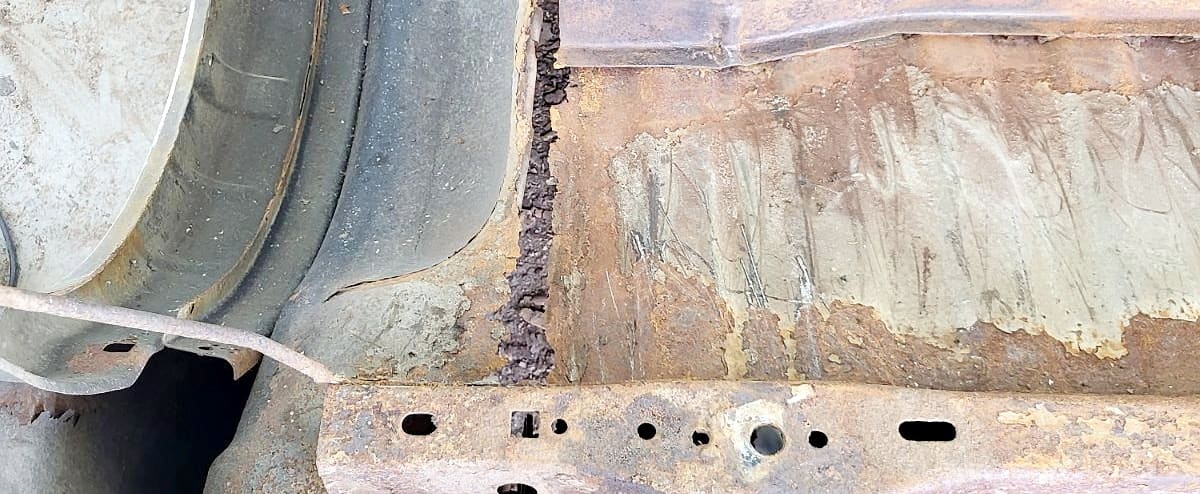The increasing number of parts and frequent model changes are creating a headache for the automotive industry, to the point where owners of vehicles barely more than 10 years old are unable to put them back on the road.
• Read also: Motorists will pay more for their recycled parts
A reader of Newspaper had to change the transmission of his 2011 F-150 pickup truck due to a structural rust problem.
She claims that the dealer told her that the part is no longer manufactured. Same thing with the recyclers she contacted, who told her that finding this part would be a miracle.
The transmission supports on a 2011 Ford F-150 had to be replaced because the new or used part could not be found.
Courtesy photo
Since the rest of the vehicle was still very good, she had the base of the box remade from metal plates and supports.
“For an F-150 from the year 2000, for example, there were seven box models, but for a 2011 there are 24. So you understand that we need a much larger inventory to meet to the same request,” explains Éric Pellerin of the Recyclage Pellerin company in Plessisville.
It changes all the time
It becomes very complicated for recyclers to maintain and manage such a wide range of parts.

Éric Pellerin, boss of the Recyclage Pellerin company in Plessisville in his office.
Provided by Recyclage Pellerin
“The equipment has become very complex. A vehicle will have an automatic window in one direction or in both directions or not at all. Same thing for the steering wheel, which on a model can be heated or not, the navigation, the suspension or the body moldings. The more things go, the greater the number of options available in a vehicle,” adds Mr. Pellerin.
George Iny, from the Association for the Protection of Motorists (APA), agrees in the same way in the case of new parts.
“There is a lot of exaggeration among manufacturers at this level. This year, Ford claims to have significantly reduced the number of option combinations for the F-150. This does not reduce the number of parts, but it will simplify ordering and inventory management at dealerships. Furthermore, the shorter replacement cycle means that parts change more often, which increases their number over time,” he laments.

George Iny, president of the Association for the Protection of Motorists (APA).
Stéphan Dussault / JdeM
At least 10 years
Ford Canada recognizes that over the years, a complete box may no longer be available, but assures that the parts are.
“Most box repairs only require a few parts. If a complete replacement is required, but a fully assembled unit is no longer available, it is possible to order each part individually to replace the entire box, pending parts availability,” says Matt Drennan-Scace , Ford Canada communications.
“Replacement parts for Ford vehicles are available for at least ten years after the end of model year production,” continues Drennan-Scace. For the 2011 F-150, many parts remain available, with the understanding that supply constraints may delay parts availability in some cases.”
This 10-year period is specific to Ford. There is no specific rule in Quebec on the period of time during which a manufacturer must supply a part for a vehicle, despite the very recent updating of the law.
In the hands of the judge
“It is the courts which establish, through judgments, what is a reasonable duration for the availability of replacement parts,” specifies Charles Tanguay, of the Consumer Protection Office (OPC).

Parts clerks at Recyclage Pellerin must juggle the multitudes of models and parts on the market.
Provided by Recyclage Pellerin
Mr. Tanguay emphasizes that article 39 of the Consumer Protection Act stipulates that “if a good which is the subject of a contract is likely to require maintenance work, the spare parts and services repairs must be available for a reasonable period of time.
However, a manufacturer can release itself from this obligation by warning the consumer in writing before signing the sales contract.
Cases
Over the past 12 months, the OPC received 101 complaints for unavailability of documents under section 39.
“Very often, on new automobiles, we are talking about parts on back order (“BO”) for which the times to obtain the parts vary from several weeks to several months, or sometimes even more than a year,” underlines Mr. Tanguay .
For used vehicles, in addition to the famous “BO”, certain complaints show that the absence of a part can shorten the useful life of a vehicle (see table).
Sinister
And if, following an accident, a vehicle can no longer be driven due to a part that is no longer manufactured, the insurer is not required to pay the value of the vehicle to its owner.
“The insurer’s obligation ends at the last current price of the manufacturer’s original parts. The insurer can also take depreciation into account. The fact that the unavailable part means that the vehicle can no longer be driven does not oblige the insurer to compensate the insured for another form of loss or a total loss of the vehicle, for example,” specifies Debbie Jussome, from the Insurance Bureau of Canada (IBC).
Examples of scrapping due to lack of parts
- The battery for the electric vehicle is no longer made;
- The frame of the vehicle is rotten, but as the parts are no longer manufactured, this cannot be repaired;
- The clutch system is no longer available for a 2006 automobile;
- The engine needs to be changed. The price of the engine is $13,500 and the vehicle is worth $15,000, so the extended warranty refuses to do the repair with the $13,500 engine and offers $10,000 to the consumer.
Source: OPC
